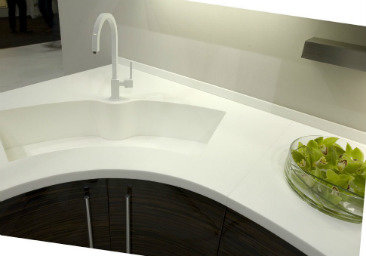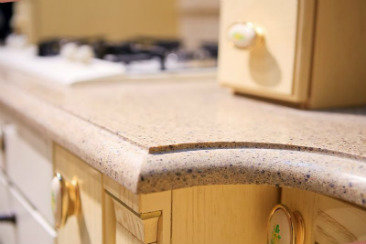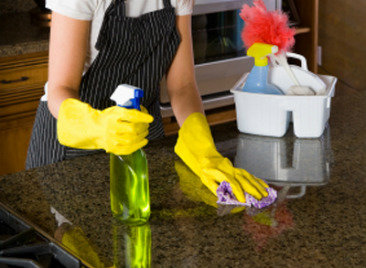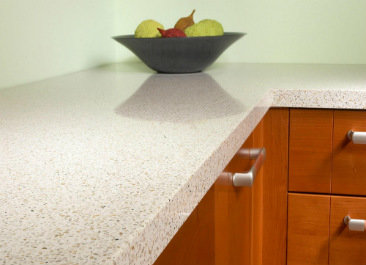Care of acrylic surfaces

Acrylic countertops are very popular today. They are relatively inexpensive, but at the same time, they completely imitate stone in appearance.
The very good quality of such countertops is that they can be absolutely any shape… That is, not only smooth, but also semicircular, with rounded edges, which is almost impossible to achieve from countertops made of natural stone or quartz agglomerate.
Also, one cannot fail to notice that acrylic countertops are quite light compared to stone ones, which means that there is no need to make strong supports to install the surface.
But, and in a barrel of honey is not complete without a fly in the ointment.
It is necessary to take care of acrylic countertops more carefully, since they are more susceptible to deterioration, they are afraid of abrasives and impacts.
You need to remember that they are afraid of only five things:
- Hot (that is, do not put hot pans)
- Hard metal brushes
- The strongest chemistry that can corrode the material
- Coloring products, drinks, substances
- Sharp piercing objects
That, in general, is all there is to know. If you put a cup of hot coffee on an acrylic countertop, nothing will happen, but a melted stain will remain from the cast iron pan.
In no case do not use chemistry, which contains aggressive substances, such as “Whiteness” or even worse, such as the toilet “Duck”. From such means, the tabletop will turn white and it will not work to remove the bright spot.
Any iron brushes are also contraindicated, since they leave micro-scratches, which become larger each time and the pattern of the countertop fades over time. And in those places where you scrub something with zeal, the same whitish spots will remain, as after caustic chemicals.
It is also not worth cutting something on a table top without a board, for the same reason. The same goes for hitting something heavy.
Following the above guidelines will help extend the life of your kitchen countertop. Otherwise, you will have to seek the help of restoration specialists or resort to replacing the countertop.
Care for quartz agglomerate countertops
Quartz agglomerate is a crumb of natural quartz that is pressed and bonded with resins, turning it all into a single mass.
Such countertops are even superior to natural stone in many ways.

In terms of hardness, they are the same, since their composition is 97% – quartz, and only 3% for pigments and resins. That is, such a tabletop takes the best from the stone – amazing hardness and wear resistance. But the pores and air gaps, which are simply mass in natural rock, are not included in the agglomerate.
And this means that such a countertop is not afraid of greasy stains, is not afraid of spilled wine, such as, for example, pure granite or marble. It is also impossible not to take into account that there is no radiation background in them, as, for example, in some granite products.
Solid pluses, despite the fact that the cost of such a countertop is a little (quite a bit, however) – lower than a stone one.
They are slightly lighter in weight than the natural breed. There are relatively many colors and they look much more natural than in the case of acrylic countertops.
Quartz agglomerate countertops are much easier to care for than acrylic countertops. That is, as such, care is not needed, you just cannot do some things.

And in the case of agglomerate countertops, you can do almost anything! You don’t need to use the board, you can drop knives on it, you can rub with the toughest iron brush, you can put hot pans, you can spill coloring liquids on them at least three times a day.
The only thing that quartz agglomerate countertops are afraid of is caustic chemistry. Since the composition of such a product is 97% stone, and the rest are binders, the stone itself will not suffer, but the resin can corrode. Of course, there will not be a continuous whitish spot, as is the case with acrylic, but all the same, this place will noticeably pale.
There is great news for the owners of such countertops: they are subject to restoration.
If, suddenly, you spoiled the surface with chemistry or dropped something so heavy that it triggered a chip, then you can always call a master who will return the product to its original appearance. This service is not the cheapest, but you will have to resort to it once every 15 years, or even less often.
How to distinguish acrylic countertops from quartz, and quartz from stone?

There are times when the owner of the kitchen does not even know what material their countertop is made of. For example, they bought an apartment with a ready-made kitchen, but did not think to ask the owners for the countertop. Therefore, caring for an artificial countertop may not be at all as it should be, since people believe that they have natural stone in front of them.
At first glance, both acrylic, quartz countertops and stone countertops are identical. But, acrylic is a very tough plastic, roughly speaking. And quartz is compressed stone chips. Therefore, resistance to chemicals and abrasive substances can be completely different. But natural stone does need special care, different from that which is recommended for artificial countertops.
How can you tell them apart?
So to speak: it is extremely difficult to distinguish natural stone from quartz agglomerate, in the event that the color is chosen such that it fully imitates the natural rock mass.
And if the colors are unusual, then we can safely say that this is an agglomerate. But for this you need to be an ace in typical stone colors, and know exactly which breed is in front of you. The colors of granite and the colors of marble are two big differences, as you can imagine.
If you wish, you can search the Internet for examples of countertop colors. The most common rocks used for countertops are granite, marble and sandstone.
Acrylic differs from stone and quartz agglomerate very simply: it is just warm to the touch, at room temperature. But stone and quartz will be quite cool to the touch.
Also, the glass (glass, shot glass) will not burst from impact on an acrylic surface, but if it hits a stone or agglomerate from a height, it will not burst. There are still differences, but you don’t need that anymore. These two signs are the most obvious and it is necessary to rely on them.
Now you know not only how to care for an artificial stone countertop, and we hope that it will last long enough to get bored!



